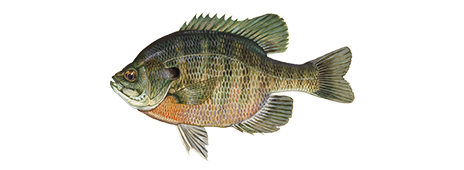Bluegill

The bluegill is one of the most popular panfish species you can find in North America. And is a fish that has become increasingly popular among fly fishing anglers.
HOW TO IDENTIFY A BLUEGILL
You can identify a Bluegill because it has a compressed, round body that is typical of the sunfishes. Its color is highly variable and many range from dark blue or bluish-purple to yellow, and in some cases, it may even appear to be clear or colorless.
The Bluegill usually has 6 to 8 vertical bars on the sides, which may or may not be prominent. The cover peaks into a broad, round flap that is black in color; however, it is not surrounded by a lighter colored trim as it is in some other sunfishes. You can easily identify a Bluegill because they have a small mouth and head that are typical of sunfish species and the pectoral fins are pointed.
WHERE TO CATCH BLUEGILL
These are the places where you can catch Bluegill. This fish species is native to the eastern half of the United States and a small portion of northeastern Mexico and has been widely introduced elsewhere in North America as well as into Europe and South Africa.
The following are different places where you can find and catch Bluegill:
Gradual Shores Holes Inlets and Outlets
Open Water Piers, Docks and Pilings Shoreline Shallows
Spring Holes Sunken Objects Walkways and Bridges
Freshwater Weed Beds
HOW TO CATCH BLUEGILL
There are different ways how you can catch Bluegill. Fly fishing for bluegills has become increasingly popular, and light tackle anglers have long found it to be one of the best action fish, ounce for ounce, that can be caught.
The following are fishing methods you can use to catch bluegill:
Drift Fishing Fly Fishing
Torlling Still Fishing
BLUEGILL LURES, TACKLE & BAIT
The following are fishing lures, tackle and bait you can use to catch bluegill:
Flies Insects
Jigs Minnows